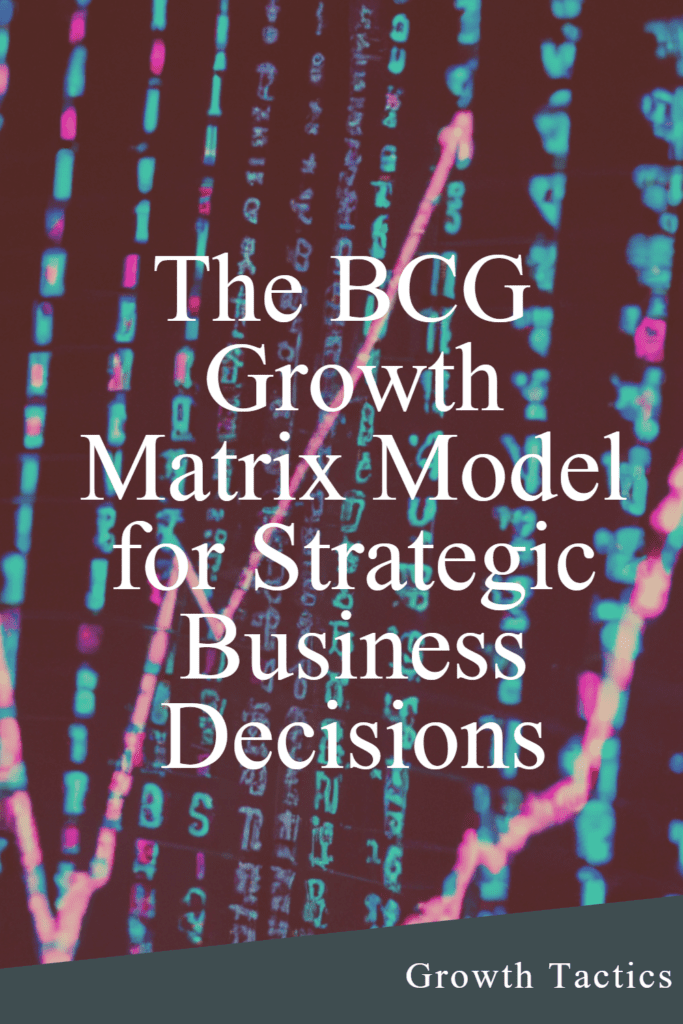If you’re a business leader, you know that making informed decisions is key to success. One powerful tool you can use is the BCG growth matrix model. This matrix, also known as the growth matrix or the share matrix, helps businesses assess their product portfolio and decide where to focus their resources and capital. In this article, we’ll dive into the details of this model and how it can help improve your business strategy.
Jump To Section
What is the BCG Growth-Share Matrix?
The BCG growth-share matrix is a strategic planning tool developed by the Boston Consulting Group in the 1970s. It’s a visual representation of a company’s product portfolio that allows businesses to identify which products are generating the most value and which should be invested in or discarded. The matrix places products into one of four categories: cash cows, stars, question marks, and dogs.
The Four Categories
- Cash Cows: These are products that have a large market share but a low growth rate. They generate much cash for the company and are considered to be in the lower right quadrant of the matrix.
- Stars: These are products that have a high market share in a high-growth market. They are considered to be in the upper left quadrant of the matrix and have a strong future cash generation potential.
- Question Marks: These are products that have a low market share in a high-growth market. They are considered to be in the upper right quadrant of the matrix and have the potential to become either stars or dogs.
- Dogs: These are products that have a low market share in a low-growth market. They generate little cash for the company and are considered to be in the lower left quadrant of the matrix.
How to Use the BCG Growth-Share Matrix
To understand how to use the BCG growth-share matrix, it’s important to break down the two factors that are being assessed: relative market share and market growth rate.
Relative Market Share
Relative market share is defined as a product’s market share relative to that of its largest competitor. It’s calculated as a ratio between the product’s own market share and the market share of its largest competitor.
A high relative market share indicates that the company is a market leader; it has a higher market share than its competitors. On the other hand, a low relative market share indicates that the company is a smaller player in the market.
In order to calculate relative market share, a company needs to gather information about the market share of its products and the market share of its competitors. This can be done through market research or by using industry reports.
Market Growth Rate
Market growth rate refers to the current rate of growth of the market in which the product is competing. If the market is growing rapidly, it’s considered a high-growth market. If the market is barely growing or not growing at all, it’s considered a low-growth market.
To determine the market growth rate for a particular product, a company needs to examine the historical growth rates of the market. This data can be gathered from industry reports or through market research.
How to Apply the BCG Growth-Share Matrix
When it comes to applying the BCG growth-share matrix to analyze a company’s product portfolio, there are a few key steps to follow. By following this process, you can gain valuable insights that will help inform your strategic business decisions. So, let’s dive in and explore how you can effectively apply the BCG growth-share matrix.
- Identify your products: Start by identifying the products within your company’s product portfolio that you wish to analyze using the BCG matrix. This could include a range of products across different markets or industries.
- Determine the market growth rate: For each of the identified products, it’s essential to determine the current market growth rate for the specific market in which the product competes. Understanding the growth rate will provide vital context for the analysis.
- Determine the relative market share: After establishing the market growth rate, calculate the relative market share for each product. This involves comparing the product’s market share to that of its largest competitor. This insight helps you gauge the product’s position within the market.
- Plot the products on the matrix: With the data gathered, it’s time to plot each product on the BCG matrix. Draw a grid with the market growth rate on the y-axis and the relative market share on the x-axis. Place each product as a dot on the grid based on their respective values. This will visually represent their position within the matrix.
- Analyze the matrix: Once all the products are plotted, take a step back and analyze the matrix as a whole. Identify which products fall into which category: cash cows, stars, question marks, or dogs. This analysis will provide insights into the current state of your product portfolio.
- Make strategic decisions: Armed with the information from the matrix, it’s time to make strategic decisions. Consider the characteristics of each category and decide how to allocate resources and capital accordingly.
- For cash cows, focus on maintaining their profitability and consider using the generated cash to invest in other growth areas or reward shareholders.
- With stars, make investments to capitalize on their strong market position and potential for further growth.
- Question marks require careful evaluation. Assess their potential for growth and decide whether to allocate resources to turn them into stars or consider divesting from them.
- Dogs may not be generating significant value and can drain resources. Determine whether to revamp or phase out these products.
Remember, applying the BCG growth-share matrix is an ongoing process. Regularly reassess your product portfolio using the matrix to adapt your strategic decisions as market conditions change.
By following these steps and utilizing the BCG matrix effectively, you can gain valuable insights into your product portfolio and make informed decisions to drive your business forward.
Examples of Using the BCG Matrix
As fellow business leaders, it’s always helpful to have practical examples to understand how a strategic tool like the BCG matrix can be applied in real-world scenarios. So, let’s dive into some examples of how companies have effectively used the BCG matrix to make informed decisions and drive their business growth.
Example 1: Technology Company
Imagine a technology company that offers a range of products, including smartphones, tablets, and smart home devices. By using the BCG matrix, the company can categorize each product into one of the quadrants: stars, question marks, cash cows, or dogs.
- Stars: The company’s latest smartphone model could be identified as a star because it has a high relative market share and is experiencing rapid growth.
- Question Marks: Some of the newer smart home devices might fall into the question mark category. They have the potential for growth, but their market share is still uncertain.
- Cash Cows: The company’s well-established tablet product line, while not experiencing high growth, has a solid market share and generates steady revenue. It can be considered a cash cow.
- Dogs: Older models of smartphones that are no longer popular or generating significant sales may be categorized as dogs because their market share is declining.
Based on this analysis, the company can allocate resources accordingly. For example, they may choose to invest more in marketing and product development for the stars and question marks while optimizing costs and maximizing profits from the cash cows.
Example 2: Retail Chain
Let’s consider a retail chain operating in the fashion industry with various product lines, such as clothing, accessories, and footwear.
- Stars: The company’s trendy clothing line that is popular among customers and experiencing consistent growth can be identified as a star.
- Question Marks: The accessories line might be considered a question mark due to its smaller market share and potential for growth.
- Cash Cows: The classic footwear line, although not experiencing high growth, has a loyal customer base and generates reliable revenue.
- Dogs: A particular clothing line that is no longer in style and has low sales could be classified as a dog.
By using the BCG matrix, the retail chain can focus on investing in marketing and innovation for the stars and question marks while making strategic decisions about the dogs. They can also continue to optimize profits from the cash cow products to support other areas of the business.
These examples demonstrate how the BCG matrix can provide insights into product portfolio management, resource allocation, and growth strategies. By categorizing products and understanding their relative market shares and growth rates, companies can make informed decisions to drive success in their respective industries.
Remember, the BCG matrix is just one tool in a business leader’s toolkit, and it’s important to consider other factors and industry-specific dynamics when making strategic decisions.
Limitations of the Growth Matrix: What You Need to Know
As seasoned business leaders and managers, you’re likely well-versed in the use of business strategy tools such as the growth matrix. While it can be a useful tool for analyzing your company’s portfolio and making informed decisions about resource allocation, it’s important to be aware of its limitations.
At our company, we believe in providing clear, concise information in a friendly and approachable manner. We’re here to offer advice, share insights, and help you make informed decisions. So, let’s take a closer look at the limitations of the growth matrix in a way that’s engaging and accessible.
One of the key limitations of the growth matrix is the amount of data and analysis required for its effective use. Without the necessary data, the accuracy and effectiveness of the matrix can be limited. Additionally, the matrix’s focus on only two factors, relative market share, and growth rate, may not be sufficient for all companies or industries.
Another limitation to consider is the assumption that all products will follow the same growth trajectory. In reality, a product may experience high initial growth but then level off or decline, making it difficult to accurately categorize with the matrix. Furthermore, external factors such as technological advances or changes in consumer behavior are not accounted for, but can dramatically impact a company’s products and growth prospects.
Lastly, the growth matrix may not be as effective in rapidly changing industries or markets where growth rates and market share can shift quickly. In these cases, the matrix may not provide a clear picture of a company’s portfolio or future prospects.
By understanding the limitations of the growth matrix and using a data-driven approach to strategic decision-making, your company can remain competitive in its industry and achieve long-term success.
Checklist for Conducting a BCG Matrix Analysis
Conducting a BCG matrix analysis is an invaluable exercise for strategic business planning. To ensure a thorough and effective analysis, follow this checklist:
1. Identify Your Products
- List all products or business units: Create a comprehensive list of the products or business units you want to analyze using the BCG matrix.
- Gather data: Collect all necessary information about each product, including sales data, market share, and growth rates.
2. Determine Market Growth Rate
- Research industry trends: Look for industry reports or conduct market research to understand the growth rate of each product’s market.
- Analyze historical data: Examine the historical growth rates to establish whether the market is high or low growth.
3. Determine Relative Market Share
- Calculate your market share: Determine the market share of each product relative to its biggest competitor.
- Use a ratio: Express market share as a ratio between your product’s share and the largest competitor’s share to gauge competitive position.
4. Plot Products on the BCG Matrix
- Create the matrix grid: Draw or use a digital tool to create a grid with the market growth rate on the y-axis and relative market share on the x-axis.
- Place each product: Plot each product on the matrix based on the calculated market growth rate and relative market share.
5. Analyze Matrix Results
- Categorize products: Identify which products fall into the categories of cash cows, stars, question marks, or dogs.
- Evaluate positioning: Assess the current position of each product and plan strategic actions accordingly.
6. Make Strategic Decisions
- For Cash Cows: Focus on maintaining their profitability and use profits to support other areas.
- For Stars: Invest to maximize growth and capitalize on high potential.
- For Question Marks: Evaluate their potential; decide whether to invest further or divest.
- For Dogs: Consider phasing out low-performing products to free up resources.
7. Reassess Regularly
- Continuous monitoring: Regularly reassess the product portfolio using the BCG matrix.
- Adapt to changes: Update strategies based on shifting market conditions and product performance.
By following this checklist, you can ensure a systematic approach to conducting a BCG matrix analysis, leading to more informed and strategic business decisions.
Takeaways
- The BCG growth-share matrix is a valuable tool for businesses to assess their product portfolio and make informed decisions.
- The matrix places products into one of four categories: cash cows, stars, question marks, or dogs.
- Analyzing a company’s product portfolio using the BCG matrix involves assessing each product’s relative market share and market growth rate.
- By plotting products on the matrix, businesses can identify which products they should invest in or discard, and where to focus their resources and capital.
Remember to regularly assess your business using the BCG matrix to help improve your strategic business decisions. By continuing to focus on the right products, you can achieve sustained growth and long-term success.








